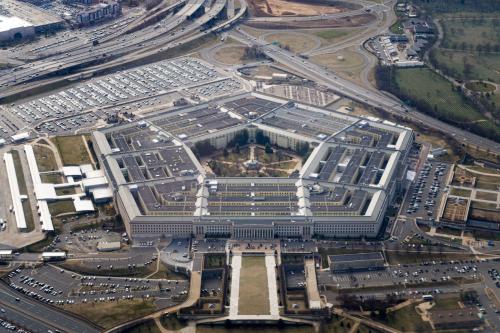In the stodgy world of defence planning, where strategy often seems to consist of finding ways to shave 5 per cent off the cost of a fighter programme, the US has embarked on a genuinely interesting task—rethinking the basic logic of its global military basing system.
The new US scheme does not reflect a radical transformation of defence technology and tactics so much as a response to changes in the geostrategic setting over the last 15 years. Among other implications, the Pentagon plan would drastically reduce forces in Germany while shifting some troops to smaller facilities in eastern Europe. It would also scale back US personnel in east Asia, especially in South Korea, while repositioning many who remain on the peninsula.
The global basing review follows changes resulting from the wars in Afghanistan and Iraq. Notably, the US now has access to some military facilities in central Asia, a substantial force in Afghanistan and an enormous presence in Iraq as well as Kuwait; and it no longer has a presence in Saudi Arabia or Turkey.
Many allied officials, especially in Germany and South Korea, see the plan as Washington’s reprisal for recent spats over policy on Iraq and North Korea. It is true that Donald Rumsfeld, the US defence secretary, has sometimes been supremely undiplomatic in his dealings with allies. But the plan, which makes generally good strategic sense, was clearly not drawn up out of spite.
The US now has about 400,000 uniformed personnel abroad out of slightly more than 1.5m full-time troops and activated reservists. Roughly 100,000 US troops are in Europe, with over half in Germany. Of about 100,000 troops in east Asia, just over 40,000 are in Japan and nearly the same number in Korea. The remaining US forces abroad are nearly all in Iraq, Kuwait, other parts of the Persian Gulf region and in central Asia.
If reports are correct, the draft plan would recall all four heavy combat brigades in Germany (the better part of two American divisions), and replace them with just one brigade, a medium-weight unit. Overall, US troop strength in Germany would be nearly halved. Basing arrangements would be developed in several of the new Nato member states of eastern Europe, generally involving much smaller and temporary deployments. In east Asia, cuts would probably amount to about 20,000 uniformed personnel, mostly from South Korea. Much of the east Asia reduction would result from streamlining redundant command headquarters. In addition, the US would redeploy one of its two army brigades normally in South Korea to Iraq. After that tour, the brigade would return to the US instead of to South Korea.
Most of the Rumsfeld plan makes sense. In Europe, given the absence of a conventional land threat to Nato, there is a good argument for US forces to become smaller, lighter and quicker. A smaller, more mobile US force in Europe would find training easier than it is at present in heavily populated Germany. It could exercise more easily with new Nato members. It would also provide a model of rapid deployability that most European militaries need to emulate. If US heavy forces once again needed to deploy en masse to the Persian Gulf or elsewhere, they could do so almost as quickly from the US as they could from Germany.
In east Asia, streamlining command structures and moving US military headquarters in Korea out of heavily populated Seoul are measures long overdue. Similarly, given South Korea’s increasingly capable military forces, the US Army’s 2nd Infantry Division is no longer needed near the Demilitarised Zone; it would be better to redeploy it south of Seoul where it could prepare for a US-South Korean counter-offensive outside the range of North Korean artillery. One US brigade is enough to keep in Korea in peacetime. Any counter-offensive would require waiting for a massive reinforcement from the US anyway, and the army badly needs the extra forces in Iraq right now.
As for the broader regional implications of the reduction, say for possible contingencies in the Indonesian or Taiwan straits, US naval and air assets would probably be more useful than army forces. The former are currently being modestly enhanced in the region, in Guam and elsewhere.
There are, however, some problems with the proposal for a new, global strategic architecture. The most serious is about timing. Today’s US army is at breaking point. Overseas over-deployment poses the greatest challenge to the all-volunteer force in its 30-year history. This is why the Korea plan makes so much sense. But given the strains of the Iraq and Afghanistan missions, it would be a big mistake to deploy substantial numbers of US army soldiers on unescorted tours to eastern Europe—and away from the soldiers’ home base and their families—any time soon. The army cannot afford to add more deployments to its existing itinerary now.
The plan’s likely effects on the US Marine Corps also still needs work. Washington and Tokyo have not yet agreed on how to reduce the 20,000 marines normally deployed or based on Okinawa, a densely populated island offering mediocre training opportunities and an unenthusiastic local population. In fact, the excessive US presence on Okinawa puts the broader American base network in Japan at some risk. Some of the marines should be relocated, within the east Asia region if possible and back to the US if necessary.
Overall, the new strategy needs refining and will also require patient, gradual implementation. As with most things “Rumsfeldian”, it has suffered from heavy-handed US diplomacy toward important allies. But if Mr Rumsfeld et al can fix the technical problems while the Bush administration repairs damage with the allies, the basing plan will merit strong support at home and abroad.

Commentary
Op-edAmerica’s Welcome Military Rethink
June 24, 2004